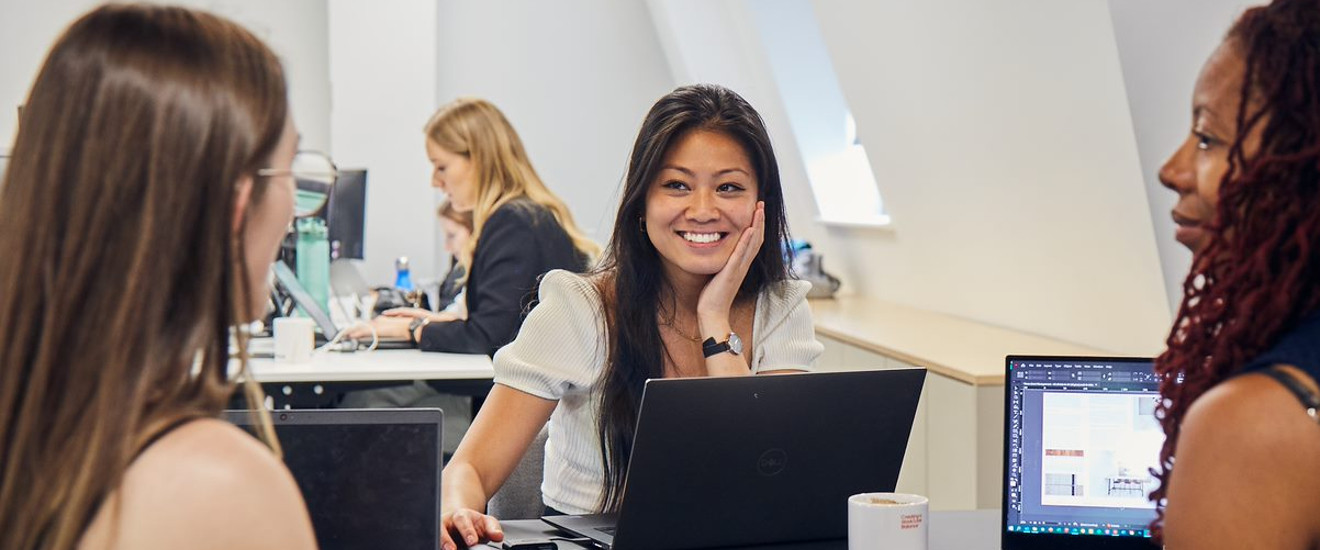Collaborative workspaces in the new era of office design
Discover how innovative office design fosters collaboration and community. Explore expert insights from Peldon Rose on creating spaces that inspire your team.


Office design continues to evolve to support collaboration in a hyrbid work environment. In this blog, we explore key strategies for fostering teamwork and connection in the workplace, as well as the role of flexible and adaptive office spaces in driving innovation, expertise, and teamwork.
This approach will help to bring teams together and champion both creativity and innovation. A lot of this comes down to people’s actions, but how can you create a collaborative way of working through office design?
What is a collaborative workspace?
Collaborative workplaces aren’t a new concept, but with the changing landscape of the office and more flexibility around where employees may choose to work in the future, it is essential that these spaces unite employees. An office needs to be somewhere staff are able to work together, rather than an extension of the isolation some employees experience during remote work. By integrating activity-based working areas and supporting the ways your team communicates, your office can accommodate different needs and working styles – and as a result, the space adapts to your team’s requirements.
Collaborative workspace design approach
A collaborative workspace design approach focuses on creating environments that support diverse work styles while fostering collaboration, creativity, and individual productivity. Consider:
-
People-first planning: A collaborative workspace should begin with a deep understanding of how teams work best. Designing spaces that support different working styles, such as open areas for collaboration and quiet zones for concentration, supports task-based work and ensures the office suits individual needs.
-
Balance between collaboration and focus: It's essential to find a balance between environments for teamwork and spaces that allow for deep concentration. Collaborative areas should encourage communication and brainstorming, while designated quiet zones provide employees with the solitude needed for focused tasks.
-
Cultural integration: Office design should reflect and align with the company’s values. By incorporating elements that reinforce the organisation’s culture, the workspace becomes a place where employees feel a sense of belonging, fostering collaboration and strong team dynamics.
-
Scalability and adaptability: Spaces should be designed with flexibility in mind, able to evolve as the company grows or adopts hybrid working models. This ensures the workspace remains relevant and supportive of the organisation’s needs in the long term. Consider occupancy analysis to highlight which areas have the potential to accommodate fluctuations in headcount in your office.
For more details on innovative workspace solutions, explore our design for Park Now, a growing tech-led business.
Understanding the needs of individuals and teams is vital to getting a collaborative workspace design right. It is part of Peldon Rose’s strategy stage of office planning. Our workplace strategists are a team of experts who help you identify the intricate workings of your business. By delving into every facet of your team’s working style, and conducting studies like the aforementioned occupancy analysis, they determine how to unlock the potential of your workforce through office design.
What are the benefits of a collaborative workspace?
Collaborative workspaces offer numerous benefits that enhance both individual and organisational performance. By fostering seamless idea sharing, these environments allow teams to collaborate freely without the need for formal meetings or presentations, leading to increased innovation and efficiency. Additionally, features like breakout areas, informal meeting rooms, and open-plan designs help reignite company culture by reconnecting employees after time away, strengthening team cohesion and communication. Such spaces also encourage spontaneous collaboration, providing opportunities for employees to connect casually, which can lead to new ideas and innovative solutions.
Open collaboration reduces feelings of isolation, fostering a sense of community and improving employee satisfaction. Notably, research indicates that 87% of people would work flexibly if they could, highlighting the importance of adaptable work environments. An exemplary project showcasing these principles is the collaborative office interior refurbishment Peldon Rose completed for The Leverhulme Trust. This transformation created a contemporary office supporting agile working and interdisciplinary collaboration, aligning with the organisation's commitment to fostering a dynamic and inclusive work culture.
For employees who are beginning their careers, collaborative spaces also provide an opportunity to learn from colleagues and they help them to develop within a company. By allowing for this type of collaborative learning employees will be less likely to seek new opportunities and this can have a direct impact on retention rates. Our blog on creating a learning culture through office interior design has more information on this.
How can I create a collaborative office space?
To develop a collaborative space, it’s necessary to redetermine the dynamics of your office. An understanding of how your team works needs to inspire the design. Depending on the nature of your work and your team, shifting towards a collaborative approach might be as simple as rethinking the furniture, or it could mean a complete overhaul of the layout of the office.
Collaborative spaces like breakout areas, with tables and chairs outside of regular desks or meeting rooms, can help foster an atmosphere of collaboration, while areas designed for brainstorms or for eating lunch can bring the team together in new ways and provide them with resources to create something new.
Flexible workplace design ideas to promote collaboration
Implementing flexible workplace design strategies can significantly enhance collaboration, creativity, and overall employee satisfaction. Consider the following elements to help employees deliver their most engaged work:
-
Flexible open-plan layouts: Open-plan designs promote familiarity among staff members and encourage various forms of collaboration.
-
Dedicated collaboration zones: Designating specific areas for meetings and group discussions fosters teamwork and idea exchange. Peldon Rose's design for ECI Partners exemplifies this approach, transforming their London office into a space that enhances collaborative capacities and reflects the company's culture.
-
Visual displays: Incorporating whiteboards, writable walls, or idea boards facilitates easy sharing and generation of ideas, supporting spontaneous brainstorming sessions. Consider having these as modular or moveable pieces of office furniture, ensuring a space can be adapted to suite functional needs day to day, and hour to hour.
By integrating these design elements, organisations can create adaptable workspaces that not only promote collaboration but also support diverse working styles and enhance employee engagement.
Summary
Collaborative workspaces are designed to foster teamwork and communication. These spaces adapt to various working styles by offering versatility and choice in the office environment. The aim of collaborative workspace deisng is to unite employees and provide environments that support diverse needs.
The benefits of collaborative workspaces are:
- Enhanced Idea Sharing: Facilitate free-flowing collaboration without the necessity for formal meetings, boosting innovation and efficiency.
- Reinforcement of Company Culture: Features like breakout areas and open-plan designs reconnect employees, strengthening team cohesion.
- Spontaneous Collaboration: Encourage casual interactions, leading to new ideas and innovative solutions.
- Improved Employee Wellbeing: Reduces feelings of isolation, fostering a sense of community and enhancing job satisfaction.
- Adaptability: Align with the growing demand for flexible working options, with 87% of the UK’s full-time workforce expressing interest in such arrangements.
If you're interested in how Peldon Rose can help you design a collaborative workspace, contact us today or check out more from our News & Insights hub.
You may also like
SharkNinja's transformative new workplace guided by Feng Shui
Mondrian establishes a new frontier for workplace design
VaynerMedia’s revolutionary new London workplace design
Empowering exceptional business for Dale Underwriting Partners

Start your workplace transformation today.
Your workplace holds enormous potential to improve your business performance. Get in touch today, and we will unlock that potential together.



